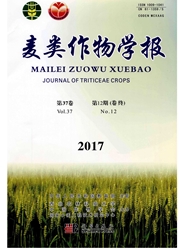

 中文摘要:
中文摘要:
为了研究西藏青稞抗旱的分子机制,以西藏耐旱青稞(Hordeum vulgare L.var.nudum HK.f.)品种喜玛拉雅10号为材料,利用抑制性差减杂交技术(SSH)构建青稞苗期叶片干旱胁迫诱导基因表达的正向差减文库。挑取600个阳性克隆进行PCR验证,并对验证后的单克隆进行测序分析,共获得420个有效序列。去除冗余序列和嵌合序列后,获得220条高质量EST序列,其中183条singlets,37条contigs。BlastN分析表明,其中189个EST序列可以在GenBank的unigene中找到同源序列,31个未能找到unigene同源序列;BlastX分析表明,62个EST序列unigene与未知功能蛋白或假定蛋白有较高的相似性;158条EST序列与已知功能蛋白有较高的同源性。获得的EST序列多数不仅与植物的非生物胁迫相关,也与植物的生物胁迫反应相关,说明植物在胁迫反应中有明显的共同机制。其中与大麦表达序列高度同源的EST占58%;这些基因涉及参与信号转导和转录调节的基因(11.96%),编码保护、防御和胁迫耐受蛋白的基因(9.78%),跨膜转运相关基因(5.43%),光合作用基因(6.52%),参与结构和功能代谢合成途径中的一些酶(30.43%)等代谢过程。实验结果表明,青稞在干旱复水条件下可诱导一系列特异基因的表达,如参与抗旱反应相关酶和蛋白基因锌指蛋白、衰老相关蛋白、CAS、细胞色素P450、热激蛋白、胁迫诱导蛋白,以及LEA蛋白、脱水蛋白、P5CS等保护蛋白基因。用KOBAS系统将56个EST定位到32个Pathways中,初步分析发现,谷氨酸盐代谢途径(Glutamate metabolism)、精氨酸和脯氨酸代谢途径(Arginine and proline metabolism)、泛素蛋白介导的蛋白质水解代谢(Ubiquitin mediated proteolysis)途径可能与青稞抗旱相关性较大。
 英文摘要:
英文摘要:
A forward cDNA-SSH library was established by suppression subtractive hybridization u- sing seedling leaf of Himalaya 10, a drought-tolerant Tibet barley (Hordeum vulgate I.. var. nudum HK. f. ), among which 600 positive clones were selected for sequencing, after detection by PCR for each clone, each single clone was sequenced. Totally 420 available sequences were assembled and 220 uniESTs, in which 37 contigs and 183 singlets were obtained by cluster analyses of the ESTs. The re- sults of BlastN showed that 189 ESTs had homologous sequences in unigenes database of GenBank, while the other 31 ESTs had no protein homologous. The BlastX results indicated that 158 ESTs had significant homology with proteins encoded by unigenes and 62 were unknown proteins and putative proteins. Most of those genes were not only related to abiotic stresses, but also related to biotic stres- ses in plants, which suggesting the cross-interactions in response to different stresses in plants, and 58 % of the ESTs were homologous with barley ESTs. These UniGenes involved in signal transduction and transcriptional regulation (11.96%), encoding protection, defense and stress protein (9. 78%), transport related (5.43%), photosynthesis genes (6.52%), and enzymes for structure and function of metabolic synthesis pathway and other metabolic processes (30.43G). The experimental results in- :ticated that the barley can induce a series of specific expressed genes in the drought-rehydration condi- Lions, not only some known enzymes and protein genes participated in drought response, such as zinc protein, senescence associated protein, CAS, cytochrome P450, heat shock proteins and stress pro- eins, were found this study, but also some protective protein genes, such as LEA protein, dehydra- ed protein, PSCS. KOBAS mapped 56 ESTs of the 220 unigSTs to 32 KEGG pathways. This study uggested that the drought tolerance of Tibet barley was closely related with glutamate metabolism, rginine and proline metabolism and Ubiquitin medi
 同期刊论文项目
同期刊论文项目
 同项目期刊论文
同项目期刊论文
 期刊信息
期刊信息
